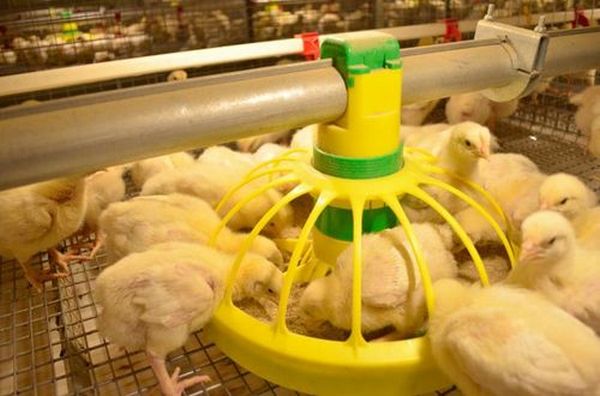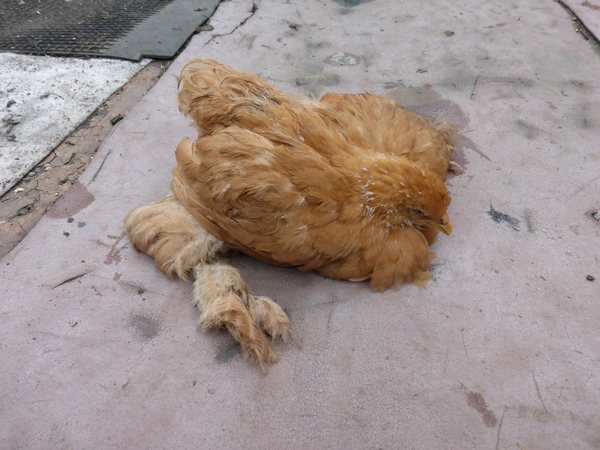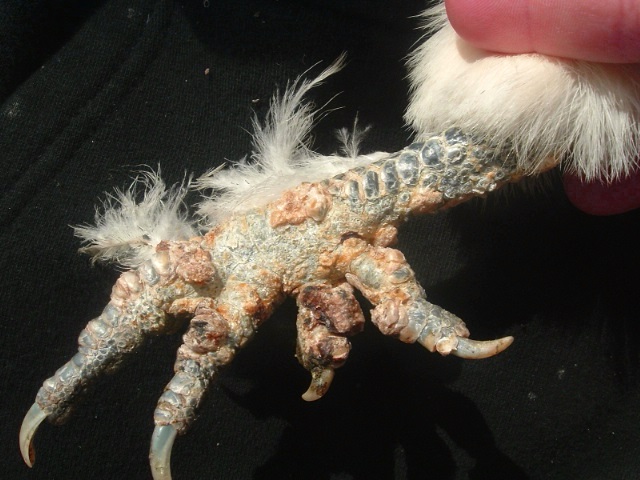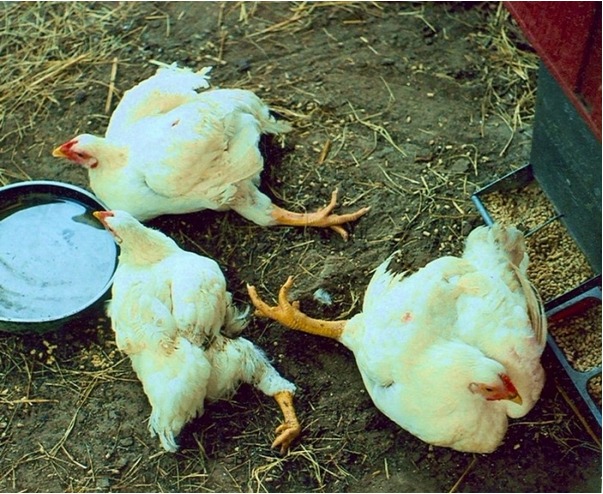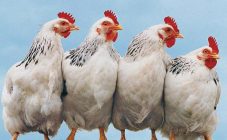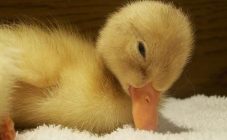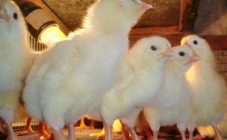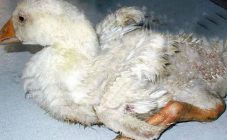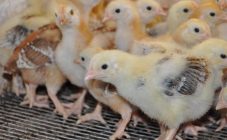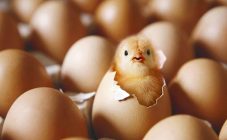Content:
In order to successfully raise hatchery chicks, healthy chicks are chosen. Otherwise, the cultivation experience will end sadly: the cost of feed will not pay off, weak individuals will die in the first days, the rest of the chickens will be significantly delayed in development and get sick. Most often, chicks sit on their feet, what to do in such situations?
Chick care rules
Distinctive features of a painless chick:
- firmly on the legs;
- moves briskly;
- responds to light and sounds;
- pecking reflex is formed;
- soft neat belly;
- tightened umbilical cord;
- clean cloaca;
- shiny sloping eyes;
- wings tightly pressed to the body.
Vulnerability is typical for chickens in the first days and weeks of life. If the chicks die, a lot of care is required. During this period, emphasis is placed on:
- maintaining the optimal temperature;
- high-quality feeding;
- abundance of water;
- provision of conditions of detention.
The diet
Proper feeding is the basis for raising chickens. High-quality food and a rational diet will allow you to grow a healthy livestock.
Experts advise sticking to the following menu:
- 1 day. They feed after about 8 hours, as the chicks hatched. Pour low-fat cottage cheese, millet, chopped yolk, sprinkled with semolina. They do not give compound feed, mash.
- 2nd day. Stir in whey or yogurt. Frequent feeding (after 3 hours), but in small portions. Boiled water is poured into drinking bowls.
- Day 5. In the summer they walk in the yard. Greens have a beneficial effect on the digestive system: clover, nettle, pre-scalded and chopped, green onions, chopped carrots. In winter, they give dried grass.
- Day 10. The emergence of the difference between breeds: broilers
and laying hens. Broiler chickens are offered compound feed in 2.5 hours. Egg-type chickens are fed mainly cereals at 3-hour intervals. The food includes a mixture of cereals that are boiled in low-fat milk or water. It is appreciated that the chicks receive calcium, which is required for the structure of the skeleton. - 3 week. The feed is enriched with vitamin and mineral supplements. Establish an alternation of dry food and mash meals. In the summer, when the chickens are walked in the daytime, the amount of food is reduced. In the evening, they get by with full portions. They leave the grain at night.
- 1 month. Transfer of chickens to the feed of the same name. Clear feeding hours, grain is not crushed, in the ration there is ordinary compound feed.
Dry feeders are suitable for bulk products that leave for a long time. The bird is given only a fresh mash. To prevent food residues from souring, they are removed after 40 minutes. The feeder is definitely washed. They drink clean water daily.
Poultry house
When keeping chickens, they adhere to the rules:
- Clean room.Cleaning up uneaten food and garbage - sources of infectious diseases.
- Periodic bedding change.
- Freedom of space. The birds must move, they are not completely limited in motor functions.
- The number of livestock. The area and number of chicks are interdependent.
Shine
The length of daylight hours depends on the age of the chicks. When chicks hatch, it is at least 18 hours. By the 4th month, the indicator gradually decreases and reaches 10 hours. The parameter is not affected by the breed of chickens. In winter, additional lighting is used.
Temperature regime
The age of the birds also affects the temperature in the barn:
- + 32 ° С - the ideal temperature for five-day-old individuals;
- + 28 ° С - suitable for chickens that are 6-9 days old;
- + 25 ° С - this is the temperature for 10-day-old babies;
- + 20 ... + 24 ° С - further temperature conditions.
About leg diseases in chickens (symptoms)
Why do chickens fall (sit) on their feet
The reasons why chickens fall to their feet are conditionally referred to:
- changes that are associated with inflammation of the ligaments and joints in chickens;
- anomalies that are caused by vitamin and mineral deficiencies during feeding;
- dysfunction due to non-compliance with the requirements for the maintenance of young animals and adults;
- diseases provoked by viruses in the limb region of a chicken;
- diseases caused by mechanical defects of tendons and paws in chickens.
Why does a chicken have paws apart
Some chicks are born weak. Often, the owners are puzzled when the chicken's legs suddenly open. It is called a helicopter or twine. When a chicken's legs are spreading, what to do? This situation is generated by negative factors. The problem occurs not only in day old chicks, but also in young birds. In large farms, if the chicks are depleted, they are usually culled and disposed of. In personal subsidiary plots in the countryside, every chicken counts. Poultry farmers are wondering what to do if the chicks are not on their feet?
The primary reasons why chicks are dehydrated include:
- poor quality flooring;
- incorrect incubation of eggs;
- irrational feeding;
- avitaminosis;
- hereditary pathologies of the musculoskeletal system;
- keeping birds in crowded conditions;
- related crossing.
If the chicks suddenly fall to their feet, what to do? A correct diagnosis is required. One of the reasons is the common cold, paralysis of the legs and frequent stress. Weakness of the legs is a manifestation of bacterial-viral, parasitic diseases.
The chick is limping in one leg
Sometimes lameness occurs when there is a lack of trace elements and vitamins in the body. The culprits are parasites and mites.
The provocateurs of changes are mechanical damage, injury:
- wounds on the legs (in contact with glass);
- abrasions;
- pinching of nerve endings;
- stretching.
The chicken has a leg twisted
If a chick is limping, it signals leg problems. Lameness sometimes develops gradually. Sometimes both legs are affected. The joints become swollen and enlarged. One gets the impression that the chick has an inverted limb. If the chicken has a slightly twisted foot, what to do? In addition, the legs are trembling. After a short run, the paws refuse to the chick.
The development of the fingers produces lameness. Eversion of paws occurs when chicks are not properly cared for: lack of vitamins, cold litter. For such individuals, drugs will not help. If the bird does not stand up, then it goes to slaughter. The signal for taking action is:
- inactivity of chickens;
- lack of oviposition;
- lethargy.
The chick broke his leg
When a chick falls from a high perch, sometimes the result of landing is injury.The chicken should be picked up and examined carefully. If the chick has broken a leg, this is a reason to go to the vet.
The chick lies on its side with its legs stretched out
Vitamin deficiency is considered the culprit. With a deficiency of vitamin B2, the bird lies on its side, stretched out its legs. An unhealthy bird has a nervous system disorder and paralysis. Other symptoms include:
- growth is delayed;
- balance is disturbed,
- paws tremble;
- fingers curl up.
How and how to treat leg diseases in chickens
Knemidocoptosis
Popularly, this disease of chicken feet is known as calcareous foot, or scabies. It is treatable at the initial stage.
Immediate isolation of sick individuals is required to avoid the spread of infection. In the barn, disinfection is carried out, the bedding is destroyed. They handle feeders, as well as egg-laying nests, tools for cleaning the chicken coop.
The tick, which settles on the body of chickens, gnaws inconspicuous passages on the legs and lays eggs. The larvae hatch quickly.
The epidermis itches all the time, without stopping. Chickens and chickens fall to their feet, hardly sleep. It is helpful for poultry houses to know why chicks get up at times and how to treat them.
Disease symptoms:
- a whitish bloom, like lime on scales that falls off;
- anxiety in chickens;
- ugly outgrowths that turn into non-healing wounds.
Therapy
To eliminate the tick, dissolve laundry soap in hot water. The legs of a chicken or laying hens are lowered into the cooled liquid, which suffer from knemidocoptosis. The water treatment takes 30 minutes. Then processing with birch tar is appropriate.
Other medications are also used:
- Ectomin. Treatment with a solution at the rate of 1 ml of the product per 1 liter of liquid. The duration of the hydro-procedure is 40 minutes.
- Mara Garden. The drug is used weekly until healing.
- Trichlormetaphos. Suitable for baths 1% solution.
- Acaryl. The gel heals wounds.
Arthritis, tendovaginitis
The disease is characterized by inflammation of the joint capsule and tissues. Mostly broilers are sick. If a chicken does not stand up on its paws with arthritis, how to treat it.
Tendovaginitis is an ailment of chicken feet, which is associated with inflammation of the tendons. Mostly adult birds are affected. If they sit on their feet, it is difficult to get up. Both mechanical lesions and viruses, together with bacteria, are responsible for tenosynovitis. Diseases of the feet appear in dirty barns and crowded chickens.
Symptoms
- lameness;
- enlarged joints;
- high temperature;
- unbalanced diet;
- tumor formations that restrict movement.
Therapy
Antibiotics are used, as well as antiviral agents:
- Polymyxin M sulfate;
- Sulfadimethoxine;
- Benzylpenicillin;
- Ampicillin.
The course of treatment: intramuscular injections for at least 5 days, or food supplementation.
Crooked fingers
Paw disease is difficult to treat. Crooked fingers appear in chicks in the first days after hatching. Chicks move on the side of the leg, as if sneaking up. Crooked fingers are associated with mistakes in care, keeping chickens in the cold, on a metal mesh. Individuals usually survive, but lameness remains, the disease is not treated.
Curly fingers
Finger curls appear in chicks with a lack of riboflavin. In addition to paralysis of the limbs, in chickens, a suspension of growth and development is noted, a fall to their feet. Keeping chickens with curly toes is impractical.
Rickets
Modification of bone tissue is noted. The chicks fall to their feet, the feather structure changes, and baldness begins. Bones soften.
The jaws and beak are characterized by elasticity, the bone and keel are soft, and the eggshell is thin. The gait of chicks resembles a penguin. Compliance with the light regime is the best prevention of rickets, which also affects egg production.
Therapy
Add minerals and vitamins to food 1 week after excretion. Chalk must be included in the feed. Treatment involves adjusting the diet, irradiation of chickens with ultraviolet light. Do not do without complexes of minerals and vitamins.
When chickens fall to their feet, they are fed with parsley, dill, green onions. In winter, chopped silage is on the menu.
You will need to add fish oil to food, coupled with a mash, ground grain, and compound feed. Dosage for young sick chickens: per 1 kg of food 1 g.
The mercury lamp PRK-2 is effective. The device is suspended 3 m from the floor. The chicks are irradiated for 3 minutes. Treatment every other day, the course is 14 days. Then a break for 10 days and repetition of the radiation.
Traditional medicine fights rickets with a few drops of vodka.
Preventive measures against depletion of chickens
To reduce damage to the musculoskeletal system and prevent the death of birds on the legs, you will need:
- walks daily on a sunlit area;
- for the luminous flux, equipment of the poultry house with fluorescent ultraviolet lamps in winter;
- maintaining relative humidity in the range of 60-80%, temperature in the range of + 12 ... + 18 ° С;
- cleaning of sharp parts of metal objects, glass in the area for walking chickens;
- the height of the perch is as much as 0.8 m, larger dimensions threaten adult hens with injuries, chickens sometimes die when falling;
- the addition of greens, sand, ash, shells, eggshells to feed will correct the situation and help strengthen the immunity of chickens and the musculoskeletal system.
So that the chickens do not get sick, it is important to treat them in a timely manner, as well as to observe preventive measures when raising poultry.
